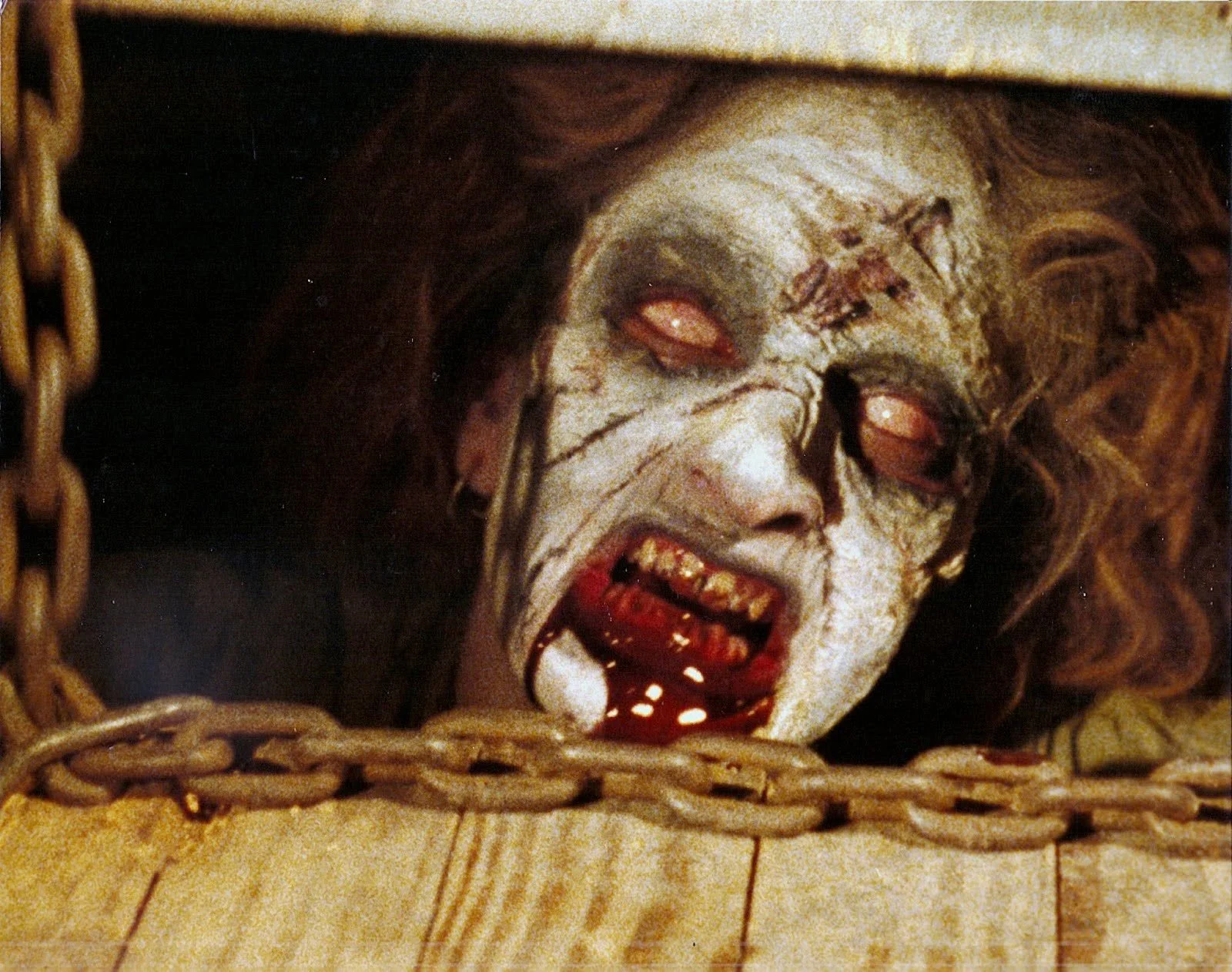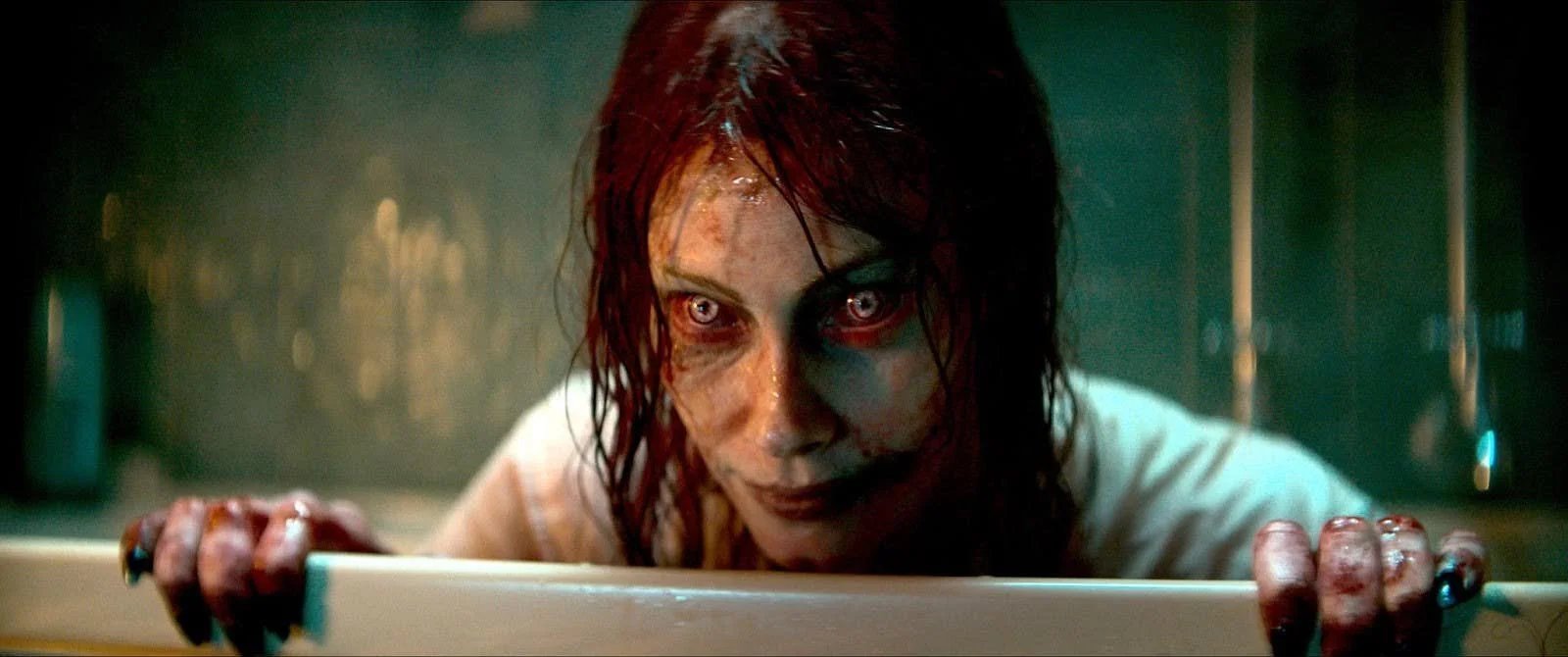Evil Dead: How One Horror Franchise Avoided Every Pitfall
Christopher Nolan’s The Dark Knight gave us the unforgettable line, “You either die a hero or you live long enough to see yourself become the villain.” As a lifelong horror fan, it seems obvious that a similar axiom is true for horror franchises: “You either fizzle out early, or stick around long enough to turn to crap.”
Okay, maybe not as eloquent as Nolan’s line, but no less true. Whether the franchise goes to space (Leprechaun, Friday the 13th, Amityville, Hellraiser), devolves into barely connected direct-to-video/streaming no-budget entries (Lost Boys, From Dusk Til Dawn, The Howling, Children of the Corn), constantly rewrites its own canon (Halloween), or suffers from one or more misguided reboots (Texas Chainsaw Massacre, Nightmare on Elm Street), horror franchises are notorious for overstaying their welcome.
Sidebar: Not all reboots are bad. I will defend Friday the 13th (2009) and Hellraiser (2022) with my dying breath.
To be clear, I love all of the franchises listed above and will earnestly defend some of their worst entries (Busta Rhymes in Halloween: Resurrection is a delight in an otherwise forgettable movie). But there’s one franchise I love more than all of these. In fact, sneaking its second entry on HBO after my dad hooked the TV in my room up to cable made 9 year old me a horror fan for life. Yet, there’s more to it than that.
The Evil Dead is a franchise that has spanned 44 years, five movies (with two more in production) and three seasons of a TV show, plus numerous comics and video game adaptations. And somehow (at least the movie and television entries) have all been objectively good entries. Sure the fans may have opinions, favorites, or ones they seldom revisit — but the production, storylines, and performances have been reliably solid and have built a cohesive and consistent lore.
Now obviously, I’m biased. I’m a huge fan of the franchise. Definitely not the biggest fan—after all, I know a woman who changed her name to Ashley because of her love for Bruce Campbell’s character Ash(ley) Joanna Williams. Despite my bias, there’s value in looking at how such a long running franchise has avoided disappointing the fans despite nearly every other horror franchise committing at least one, if not all of the sins listed above.
So let’s dive into each film or television entry in the franchise and look at why it works as a standalone piece of horror and in the context of the broader series.
The Evil Dead (1981)
The movie that started it all. The Evil Dead is the result of college friends (namely writer/director Sam Rami, producer Rob Tapert, and actor Bruce Campbell) capitalizing on the success of a proof-of-concept short and driving out to the middle of Tennessee to create a micro-budget horror film.
The film treads worn ground, even in 1981, with a story of friends headed to a cabin in the middle of nowhere who find something they shouldn’t mess with and pay with their lives. In this case they find the Natorum Demonto, or Book of the Dead, and an audio tape of an academic narrating his work with the book, including the reading of specific passages. An evil presence arrives and begins possessing the friends one at a time as the rest of the group struggles to stay alive.
A grueling shoot complete with extensive prosthetic effects and stop motion animation paid off when a sales agent at their “friends and family screening” became the film’s champion, helping get it into the Cannes Film Festival in 1982 where the buzz sold the film and paved the way for a 1983 theatrical release. Famously Stephen King reviewed the film in The Twilight Zone magazine saying, among other things, that The Evil Dead was “the most ferociously original horror film of the year.”
Despite its low budget, its rocky production and distribution, and eventually being banned in the UK, Finland, West Germany, and others, the original film is widely regarded as a classic horror gem. From its extreme gore (especially for the time), to the paranoia over who will be possessed next, to the infamous tree scene, The Evil Dead pulled no punches in its quest to terrify the audience.
Netting over $2.4M in domestic box office receipts against its $375,000 budget, The Evil Dead was a commercial success as well, opening the doors to building the film into the franchise it is today.
Evil Dead II (1987)
Despite the buzz and success, Raimi’s sequel Evil Dead II almost didn’t happen. Despite funding issues, Raimi, Tapert, and Campbell persisted and delivered something wholly different from their previous outing.
SIDEBAR: I feel it’s fairly important to make sure we’re all on the same page. Evil Dead II is not a “remake with a bigger budget” or even a “reimagining” of The Evil Dead. It’s literally a direct sequel that picks up immediately where the first film ends. However, due to rights issues and shooting the sequel in a different cabin, with changes to cast, production design, costumes, and props several years later, Raimi et al. helpfully give you a seven minute “Previously on The Evil Dead” segment so the necessary changes could be accounted for. Everything after that mark is brand new, building on Ash’s trauma from the first film in the most bonkers ways possible.
In fact, you can edit the first three movies in the franchise into one glorious four hour movie by cutting out the overlapping segments, which I happily did once they were all released in 4k.
Picking up immediately after the first movie, Ash, now trapped alone in the cabin, which itself is now possessed, slowly starts losing his mind. When the daughter of the missing academic who owns the cabin shows up, along with her fiance and some locals, they’re convinced the now insane Ashmust have killed the cabin’s owners and things begin to go poorly from there. Ash loses his hand, replacing it with the now infamous chainsaw, the book is read, allowing Ash to fuck things up further, and instead of just banishing the evil from Earth, it and Ash are sucked through a portal to England in the 1300s.
By creating a direct sequel, picking up immediately after the events of The Evil Dead, Raimi gives Campbell the opportunity of a lifetime—to create a horror icon solely through his performance, especially since he’s often acting alone against the practical effects of a possessed cabin.
By adding slapstick comedy, distorted lensing, and even more chaotic camera moves on top of Bruce Campbell’s epic comedic performance, Evil Dead II evolves beyond the horror roots of the original. While no slouch in the gore or monster departments, the film became a calling card for the singular stylings of both Raimi and Campbell. Not only that, it set a pattern of evolution and change that would become a guiding principle for the franchise.
With Dino De Laurentiis approving a budget of $3.6M, Evil Dead II went on to earn nearly $6M in its original release, but more importantly, it won the hearts of whoever was lucky enough to catch it in theaters.
Army of Darkness (1992)
Following the financial success of Evil Dead II and Darkman, De Laurentiis was able to convince Universal to match the funds he was putting up for the next sequel, and Raimi and company put it to good use.
Again picking up directly where the previous movie left off (after yet another reshot “previously on” segment) the third movie entirely eschews horror to deliver a sword and sorcery action/adventure comedy after Ash is teleported to the 1300s. This production was met with its share of conflicting opinions with Universal wanting a PG (or PG-13 at least) cut of the film. Despite Raimi reshooting a “happier” ending and cutting large chunks out of the movie, it still wound up with an R rating.
With the help of Introvision, who also did the effects for the Darkman finale, Raimi was able to use stop-motion animation in a then-state-of-the-art process that allowed more interaction and interactivity between the live action elements and the animated elements. This decision paid off dividends with Bruce Campbell returning and once again acting alone with the effects elements for large portions of the film.
Continuing the slapstick comedy but adding in an epic story, fantasy elements, and a haunting theme from Danny Elfman, Army of Darkness could have been one of the great sword and sorcery movies of the 1980s if only it had come out a few years earlier. In fact, it often makes the top 10 lists when release date isn’t an issue.
This is an obvious off-ramp for fans who are only here for the horror, but for the fans that fell in love with Bruce Campbell’s Ash, there was plenty to love. And while it is one of the lower rated franchise entries on both Metacritic and Rotten Tomatoes, it was a financial success, earning $21M worldwide off its $12M budget.
Evil Dead (2013)
The 20 years that followed Army of Darkness were filled with nearly limitless comics runs (including crossovers with Jason, Freddy, Darkman, the Re-animator, and more), three console video games, and two mobile games. It was also filled with constant rumors and questions about a new film.
Based on answers given by both Raimi and Campbell, it was never far from their minds, but it finally came together with Fede Álvarez attached to direct. While often referred to as a reboot or remake, Rami, Campbell, and Álvarez have consistently said that it takes place in the same universe and that the callbacks to the original story are intentional. Fede answered the question in a tweet saying,
“It continues the first one. The coincidences on events between the first film and mine are not coincidences, but more like dark fate created by the evil book. (Ash[‘s] car is still there rusting away.)”
Not only is 2013’s Evil Dead the first not to star Bruce Campbell, it also goes back to the strictly horror tone of the original. In fact, Álvarez’s entry seems to borrow much of its aesthetic from New French Extremity films of the early 2000s (as distinct from the American torture porn of the era), while being an early entry into the trauma-informed horror films of the 2010s. Additionally it introduces a new Natorum Demonto, called the Necronomicon in Evil Dead II and Army of Darkness, a hallmark of the newer movies used to separate them from the original trilogy while maintaining a connection.
But the changes don’t end there. Instead of looking for a weekend of booze and naughty pre-marital sex, the five college-aged adults arrive to help one of their own quit heroin cold-turkey. This story choice completely changes the vibe and gives the horror that follows an on-the-nose allegory to pull from.
Because of this, Evil Dead is brutal, primal, and never subtle. And while the original film had its gruesomeness softened by the inherent campiness of the effects the budget afforded, the 2013 entry does not suffer the same limitation. Dark and often nasty, it leaves almost nothing to your imagination.
Álvarez’s film is undoubtedly the most divisive of the franchise to date, but seemingly for a host of reasons. Many fans missed the humor and Bruce Campbell’s Ash. Horror fans in general were tired of their storied franchises getting terrible reboots and lumped this one into the pile with the others (Friday, Nightmare, The Thing, and Texas Chainsaw Massacre all having released reboots/remakes/prequels in the years just prior to 2013). Some critics thought it went too far and maybe should have left some horrors to the audience’s imagination. Others pointed out that the story of young people reading a creepy book in a cabin in the woods and unlocking horrors, while a mirror of the original film, was stale by this point, especially given 2011’s Cabin in the Woods satirical send up of the concept.
Twelve years later the film has seen a reassessment and recontextualization by fans and critics alike, and is now often regarded as fondly as the original trilogy. On top of that, it was the most financially successful entry at the time, raking in nearly $100M on its modest $17M budget.
Ash vs. Evil Dead (2015-2018)
Fans who missed Bruce Campbell in the 2013 entry would not have long to wait. Just two years after Fede Álvarez’s film, Sam Rami, Rob Tapert, and Bruce Campbell produced the first of three seasons of a television show set in the Evil Dead universe for Starz.
Picking up 20+ years after Ash returned from the 1300s (establishing the theatrical ending of Army of Darkness as canon), the show finds Ash as washed up and hopeless as he was as a young man. His only real desire seems to be proving he really is somebody in between shifts as a stock boy and random hookups in seedy bars. The show wastes no time before Ash reads from the Necronomicon (which he kept for some reason) to, of all things, impress a woman he just met.
Over the course of three seasons the show pushed the envelope of horror and comedy at every turn, built the established lore to Homeric proportions, and, most importantly, gave fans more Ash than they ever could have dreamed of having. At the same time, fans were given an absolutely phenomenal cast of characters surrounding him, brought to life through incredible performances by Dana DeLorenzo, Ray Santiago, Lucy Lawless, Lee Majors, Ted Raimi, and more.
Unfortunately, its incredible first two seasons and the constant drive to top itself would prove its undoing. Re-introducing time travel and complicated demonic mythology and returning to the cabin before setting off a world-wide apocalypse appeared to burn out the audience as viewership dwindled in the third season, leading to an abrupt cancellation from Starz. The series wrapped up with the big bad defeated and Ash waking up in a post-apocalyptic future.
While it is arguable that the show is ultimately a failed entry into the franchise (and that time travel is the Evil Dead version of going to space), it’s ultimately unfair given how good the show was initially plus the fact that viewing habits fell as people started transitioning to streaming and distributors were having a hard time knowing how to measure success in this era. It seems crazy, but DVR viewing numbers were still being tracked in 2018. While Starz may not have been willing to continue the ride, fans sprang into action, creating multiple petitions in an unsuccessful attempt to save the show.
Evil Dead Rise (2023)
Five years and one global pandemic later, Evil Dead fans were given yet another franchise entry with Lee Cronin’s Evil Dead Rise.
SIDEBAR: There’s no fully accepted theory currently on if new movies exist before the season three finale of Ash vs Evil Dead or if, due to time travel, Ash’s last few moments in the series are technically in a different timeline. Cronin, Campbell, and Raimi have all said that Rise, much like Álvarez’s entry, exists in the same universe as the show and original trilogy.
Much like Álvarez’s entry, Rise would not feature Bruce Campbell’s Ash and, other than the opening scene, would not take place at a cabin in the woods. Featuring a single mother, her three kids, and her screw up of a sister, the family is trapped on the upper floor of their Los Angeles apartment building after an earthquake. One of the kids uncovers a nasty new Natorum Demonto and records from the cult that met in the basement of their building and read the book. Evil is unleashed and the aunt Beth does her best to keep the three kids alive after the mother’s death early in the movie.
While not as brutal as the 2013 film, Cronin’s Rise is unflinching in its gore and scares while bringing back a hint of the humor from the original trilogy, as well as some crazy camerawork clearly inspired by Raimi’s entries into the franchise.
Powered by strong (and terrifying) performances by a mostly unknown cast, Cronin crafts a film that is tense and grotesque and ends up tying the franchise together.
Additionally, by introducing a third Necronomicon (or were all three introduced in Army of Darkness?, IYKYK) and breaking with the usual formula, the Evil Dead mythos is broadened even further than before. Fans now have to wrestle with the fact that, per the ending/beginning of Rise, the evil has been unleashed upon the world at large.
With an 85% on rottentomatoes.com, Rise is actually the highest rated movie of the series. Paired with a $147M gross on a $15M budget, there is no metric where Evil Dead Rise does not qualify as a success.
So what? And what’s next?
The bookends of Álvarez’s film and Rise on either side of Campbell’s series taught us how Evil Dead continues to be a successful horror franchise. The run from 2013 to 2023 shows that an Evil Dead movie or show can be whatever it needs to be for that production as long as it follows the mythos. Horror, or not horror, funny, or not funny—ultimately it doesn’t matter if it’s done well and has a malevolent book that unleashes evil upon whatever poor soul decides to read it.
Raimi, Tapert, and Campbell have retained control over their creation and, after the success of the last two movies, they all seem to be on the same page. They’ve seen that championing writers and directors with distinct voices and letting them loose in the playground that is Evil Dead has delivered for the fans and they’re hoping to keep doing the same moving forward.
After the July 2023 debut of Rise, two directors had the world premiere of their first feature films at Fantastic Fest. Sébastien Vanicek’s Infested won the festival’s main competition and got the attention of Tapert and now Vanicek’s Evil Dead Burn is slated to come out in 2026.
That same year, Francis Galluppi brought The Last Stop in Yuma County to Fantastic Fest and delighted audiences with the contained, taut crime thriller. Galluppi rode the buzz into an opportunity to pitch Sam Rami who then greenlit development of Galluppi’s as-yet untitled Evil Dead movie.
Additionally Campbell has mentioned in interviews that an animated series is in development that will continue the story of Ash vs Evil Dead.
The future looks bright for fans of Evil Dead. There’s just one thing missing… Evil Dead Rise set up what could be an incredible sequel (or series) and there appears to be no plans to move forward with it. If all the idea needs is a champion, I’m happy to pitch Rami or Tapert at Fantastic Fest this year if they’d like to take a meeting. Otherwise, I’ll happily enjoy the franchise that just can’t miss as each new installment lands.
If you enjoyed this article, please consider becoming a patron of Hyperreal Film Journal for as low as $3 a month!













Kev Dooley is a genderqueer writer, filmmaker and programmer for Fantastic Fest hailing from Austin, TX. With a deep love of bizarre genre film they seek to uncover and tell stories that delight, horrify, and expose deeper truths of the world around us.